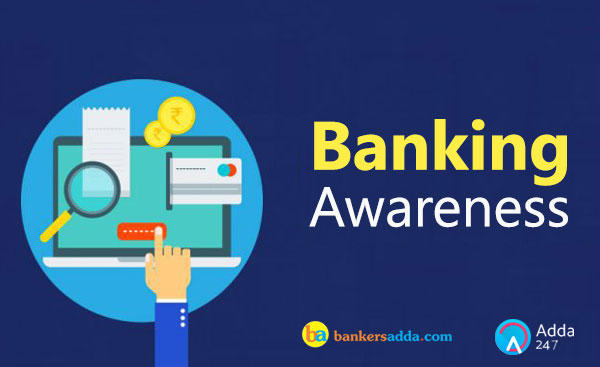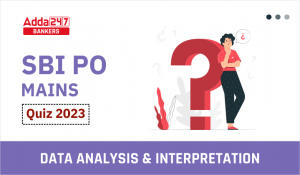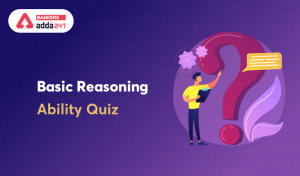Dear Aspirants,
Banking Awareness for BOB PO Exam 2018
With the increased competition in the field of banking examinations, it has now become very important to cover up all the sections efficiently. One subject that can help you bagging graceful marks in the minimum time in these examinations is Banking Awareness. Banking Awareness Quiz not only helps you deal with the General Awareness Section of Banking Exams but also, the Personal Interview round of Banking Recruitment.
Q1. Bharat BillPay transaction can be initiated through multiple payment channels like–
(a) Internet Banking
(b) Mobile-Banking
(c) Point of Sale terminal
(d) Mobile Point of Sale terminal
(e) All of the above
S1. Ans.(e)
Sol. Bharat BillPay transaction can be initiated through multiple payment channels like Internet, Internet Banking, Mobile, Mobile-Banking, POS (Point of Sale terminal), Mobile Wallets, MPOS (Mobile Point of Sale terminal), Kiosk, ATM, Bank Branch, Agents and Business Correspondents.
Sol. Bharat BillPay transaction can be initiated through multiple payment channels like Internet, Internet Banking, Mobile, Mobile-Banking, POS (Point of Sale terminal), Mobile Wallets, MPOS (Mobile Point of Sale terminal), Kiosk, ATM, Bank Branch, Agents and Business Correspondents.
Q2. Which of the following is not an objective of IMPS?
(a) To facilitate mobile payment systems already introduced in India with the Reserve Bank of India Mobile Payment Guidelines 2008 to be inter-operable across banks and mobile operators in a safe and secured manner
(b) Making payment simpler just without the mobile number of the beneficiary
(c) To enable bank customers to use mobile instruments as a channel for accessing their banks accounts and remit funds
(d) To build the foundation for a full range of mobile-based Banking services
(e) To sub-serve the goal of Reserve Bank of India (RBI) in electronification of retail payments
S2. Ans.(b)
Sol. Objectives of IMPS is given below-
1. To enable bank customers to use mobile instruments as a channel for accessing their banks accounts and remit funds
Making payment simpler just with the mobile number of the beneficiary
2. To sub-serve the goal of Reserve Bank of India (RBI) in electronification of retail payments
3. To facilitate mobile payment systems already introduced in India with the Reserve Bank of India Mobile Payment
4. Guidelines 2008 to be inter-operable across banks and mobile operators in a safe and secured manner
5. To build the foundation for a full range of mobile based Banking services.
Sol. Objectives of IMPS is given below-
1. To enable bank customers to use mobile instruments as a channel for accessing their banks accounts and remit funds
Making payment simpler just with the mobile number of the beneficiary
2. To sub-serve the goal of Reserve Bank of India (RBI) in electronification of retail payments
3. To facilitate mobile payment systems already introduced in India with the Reserve Bank of India Mobile Payment
4. Guidelines 2008 to be inter-operable across banks and mobile operators in a safe and secured manner
5. To build the foundation for a full range of mobile based Banking services.
Q3. MMID is a ____________ digit unique number issued by the bank upon registration.
(a) 7 digits
(b) 8 digits
(c) 9 digits
(d) 6 digits
(e) 4 digits
S3. Ans.(a)
Sol. Mobile Money Identifier (MMID) is a seven-digit unique number issued by the bank upon registration.
Q4. MMID stands for-
(a) Mobile Money Interface
(b) Mobile Management Identifier
(c) Mobile Money Identifier
(d) Mutual Money Identifier
(e) Mobile Money International
S4. Ans.(c)
Sol. MMID stands for Mobile Money Identifier.
Q5. *99#, a USSD based mobile banking service of NPCI was initially launched in-
(a) November 2010
(b) November 2012
(c) November 2011
(d) November 2013
(e) November 2015
S5. Ans.(b)
Sol. *99#, a USSD based mobile banking service of NPCI was initially launched in November 2012.
Q6. The rural co-operative credit system in India is primarily mandated to ensure the flow of credit to-
(a) women sector
(b) Industries sector
(c) Corporate sector
(d) Agriculture sector
(e) All of the above
S6. Ans.(d)
Sol. The rural co-operative credit system in India is primarily mandated to ensure flow of credit to the agriculture sector. It comprises short-term and long-term co-operative credit structures.
Sol. The rural co-operative credit system in India is primarily mandated to ensure flow of credit to the agriculture sector. It comprises short-term and long-term co-operative credit structures.
Q7. The short-term co-operative credit structure operates with a __________ tier system.
(a) three
(b) four
(c) two
(d) six
(e) one
S7. Ans.(a)
Sol. The rural co-operative credit system in India is primarily mandated to ensure flow of credit to the agriculture sector. It comprises short-term and long-term co-operative credit structures. The short-term co-operative credit structure operates with a three-tier system – Primary Agricultural Credit Societies (PACS) at the village level, Central Cooperative Banks (CCBs) at the district level and State Cooperative Banks (StCBs) at the State level.
Sol. The rural co-operative credit system in India is primarily mandated to ensure flow of credit to the agriculture sector. It comprises short-term and long-term co-operative credit structures. The short-term co-operative credit structure operates with a three-tier system – Primary Agricultural Credit Societies (PACS) at the village level, Central Cooperative Banks (CCBs) at the district level and State Cooperative Banks (StCBs) at the State level.
Q8. PACS is a basic and the smallest co-operative credit institution in India It works on the grassroots level (gram panchayat and village level). What is the full form of PACS?
(a) Primary Agricultural Credit Sector
(b) Primary Agricultural Credit Service
(c) Primary Agricultural Credit Societies
(d) Primary Agricultural Credit Scheme
(e) Primary Agricultural Credit System
S8. Ans.(c)
Sol. PACS stands for Primary Agricultural Credit Societies.
Sol. PACS stands for Primary Agricultural Credit Societies.
Q9. PACS are outside the purview of the _________________ and hence not regulated by the Reserve Bank of India.
(a) The Societies Registration Act, 1860
(b) National Bank for Agriculture and Rural Development Act, 1981
(c) Securities and Exchange Board of India Act, 1992
(d) Reserve Bank of India Act, 1934
(e) Banking Regulation Act, 1949
S9. Ans.(e)
Sol. The rural co-operative credit system in India is primarily mandated to ensure flow of credit to the agriculture sector. It comprises short-term and long-term co-operative credit structures. The short-term co-operative credit structure operates with a three-tier system – Primary Agricultural Credit Societies (PACS) at the village level, Central Cooperative Banks (CCBs) at the district level and State Cooperative Banks (StCBs) at the State level. PACS are outside the purview of the Banking Regulation Act, 1949 and hence not regulated by the Reserve Bank of India. StCBs/DCCBs are registered under the provisions of State Cooperative Societies Act of the State concerned and are regulated by the Reserve Bank. Powers have been delegated to National Bank for Agricultural and Rural Development (NABARD) under Sec 35 A of the Banking Regulation Act (As Applicable to Cooperative Societies) to conduct inspection of State and Central Cooperative Banks.
Sol. The rural co-operative credit system in India is primarily mandated to ensure flow of credit to the agriculture sector. It comprises short-term and long-term co-operative credit structures. The short-term co-operative credit structure operates with a three-tier system – Primary Agricultural Credit Societies (PACS) at the village level, Central Cooperative Banks (CCBs) at the district level and State Cooperative Banks (StCBs) at the State level. PACS are outside the purview of the Banking Regulation Act, 1949 and hence not regulated by the Reserve Bank of India. StCBs/DCCBs are registered under the provisions of State Cooperative Societies Act of the State concerned and are regulated by the Reserve Bank. Powers have been delegated to National Bank for Agricultural and Rural Development (NABARD) under Sec 35 A of the Banking Regulation Act (As Applicable to Cooperative Societies) to conduct inspection of State and Central Cooperative Banks.
Q10. State Cooperative Banks/District Central Cooperative Banks (StCBs/DCCBs) are registered under the provisions of State Cooperative Societies Act of the State concerned and are regulated by-
(a) NABARD
(b) RBI
(c) SEBI
(d) Government of India
(e) State Government
S10. Ans.(b)
Sol. StCBs/DCCBs are registered under the provisions of State Cooperative Societies Act of the State concerned and are regulated by the Reserve Bank. Powers have been delegated to National Bank for Agricultural and Rural Development (NABARD) under Sec 35 A of the Banking Regulation Act (As Applicable to Cooperative Societies) to conduct inspection of State and Central Cooperative Banks.
Sol. StCBs/DCCBs are registered under the provisions of State Cooperative Societies Act of the State concerned and are regulated by the Reserve Bank. Powers have been delegated to National Bank for Agricultural and Rural Development (NABARD) under Sec 35 A of the Banking Regulation Act (As Applicable to Cooperative Societies) to conduct inspection of State and Central Cooperative Banks.
Q11. BharatQR was developed by-
(a) SEBI
(b) FICCI
(c) NPCI
(d) RBI
(e) NACH
S11. Ans.(c)
Sol. BharatQR was developed by NPCI.
Sol. BharatQR was developed by NPCI.
Q12. What is the meaning of “E” in AEPS?
(a) Enabled
(b) Enquiry
(c) Equity
(d) Essential
(e) Ending
S12. Ans.(a)
Sol. AEPS stands for Aadhaar Enabled Payment System.
Sol. AEPS stands for Aadhaar Enabled Payment System.
Q13. Bharat QR Code (BQR) is P2M Mobile payment solution. P2M stands for-
(a) Person to Merchant
(b) People to Merchant
(c) Product to Merchant
(d) Personal to Merchant
(e) Primary to Merchant
S13. Ans.(a)
Sol. BQR is Person to Merchant (P2M) Mobile payment solution.
Sol. BQR is Person to Merchant (P2M) Mobile payment solution.
Q14. Which of the following is not a service Offered by AEPS?
(a) Cash Withdrawal
(b) Balance Enquiry
(c) Mini Statement
(d) Cash Deposit
(e) Cannot Deposit cash
S14. Ans.(e)
Sol. Services Offered by AePS:
1. Cash Withdrawal
2. Cash Deposit
3. Balance Enquiry
4. Aadhaar to Aadhaar Fund Transfer
5. Mini Statement
6. Best Finger Detection
Q15. Who is the Non-Executive Chairman of NPCI?
(a) Ramachandran Sundaresan
(b) Sanjay Saxena
(c) N Rajendran
(d) Dilip Asbe
(e) Biswamohan Mahapatra
S15. Ans.(e)
Sol. Mr. Biswamohan Mahapatra is the Non-Executive Chairman of NPCI. He assumed charge with effect from February 8, 2018. Mr. Mahapatra is a career central banker, career spanning over 33 years at the Reserve Bank of India (RBI) and retired as its Executive Director in August 2014.





 Quantitative Aptitude Quiz For SBI PO Ma...
Quantitative Aptitude Quiz For SBI PO Ma...
 Inequalities Basic Reasoning Quiz for Al...
Inequalities Basic Reasoning Quiz for Al...



